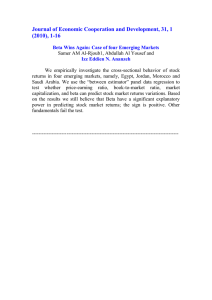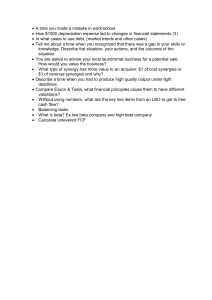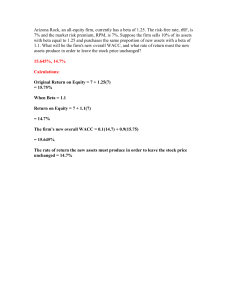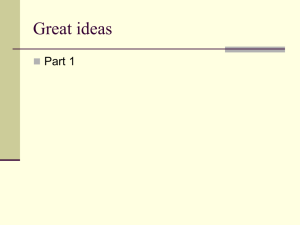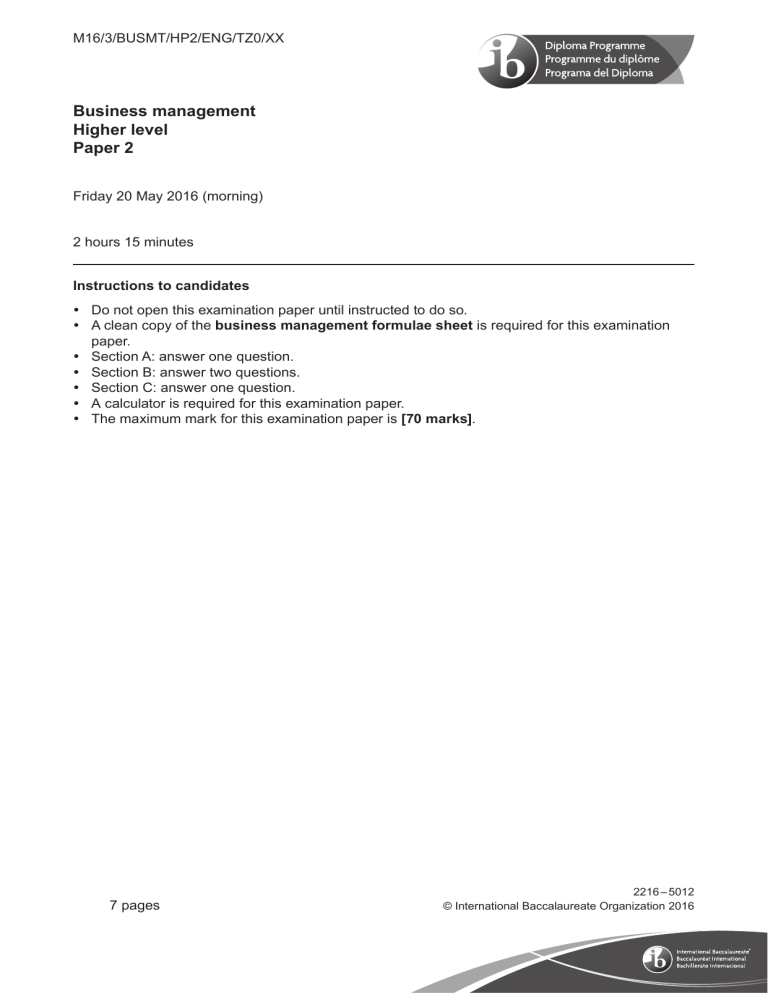
M16/3/BUSMT/HP2/ENG/TZ0/XX Business management Higher level Paper 2 Friday 20 May 2016 (morning) 2 hours 15 minutes Instructions to candidates Do not open this examination paper until instructed to do so. A clean copy of the business management formulae sheet is required for this examination paper. Section A: answer one question. Section B: answer two questions. Section C: answer one question. A calculator is required for this examination paper. The maximum mark for this examination paper is [70 marks]. 7 pages 2216 – 5012 © International Baccalaureate Organization 2016 –2– M16/3/BUSMT/HP2/ENG/TZ0/XX Section A Answer one question from this section. 1. Fair Coffee (FC) David is about to open a small coffee shop, Fair Coffee (FC), at a central city location. On opening day FC will have a stock level of 500 kg of coffee beans. David estimates that the coffee beans will be used at a constant rate for the first six months of operation. David’s planned stock management figures for the coffee beans are shown below: Maximum stock level Minimum stock level Re-order quantity level Re-order quantity Quantity used per month 500 kg 200 kg 350 kg 300 kg 150 kg Lead time for delivery of the coffee beans: 1 month. (a) State two elements of the extended marketing mix (seven Ps) for FC. [2] (b) Using the information in the table, construct a fully labelled stock control chart for FC, for the first six months of operation. [4] (c) A delivery of coffee beans was 1 month late, arriving on the last day of the seventh month rather than the last day of the sixth month. Using figures from the chart you constructed in part (b), explain the effects of: (i) the late delivery on FC’s stock level and; [2] (ii) the late arrival delivering only 75 kg of coffee. [2] –3– 2. M16/3/BUSMT/HP2/ENG/TZ0/XX Aroma Corporation (AC) Aroma Corporation (AC) is a mass-market cosmetics company that produces soaps. Concerned about falling market share and profit, AC conducted new market research. The senior management team is considering two strategic options. • Option 1: research and develop new environmentally friendly soaps • Option 2: buy new machinery to produce more of the current products The probabilities, forecast costs and revenues of each option are given below: Option 1 Forecast costs research and develop new environmentally friendly soaps $990 000 Option 2 Forecast costs a) buy new machinery $450 000 without training b) buy new machinery $475 000 with training Forecast revenue if successful Forecast revenue if not successful Probability: 0.45 $1 700 000 Probability: 0.55 $550 000 Forecast revenue if successful Forecast revenue if not successful Probability: 0.60 $1 000 000 Probability: 0.40 $250 000 $1 250 000 $200 000 (a) Describe one method (source) of secondary market research that AC could have used. [2] (b) Construct a fully labelled decision tree, calculate the predicted outcome for each option and identify the best option for AC (show all your working). [6] Explain one limitation of using a decision tree as a planning tool for AC. [2] (c) Turn over –4– M16/3/BUSMT/HP2/ENG/TZ0/XX Section B Answer two questions from this section. 3. BVC BVC manufactures canned energy drinks. It produces the market leading energy drink, Beta+, which is sold directly to, and exclusively in, sports clubs. BVC encourages intrapreneurship and innovation within its organization. To purchase Beta+ legally, the consumer has to be over the age of 18. However, many younger teenagers illegally purchase these drinks. Sales of Beta+ have grown dramatically. To have legal sales to teenagers aged 17 and below, BVC created Beta Lite, which has a much lower caffeine and sugar content than that of Beta+. Beta Lite will be sold using long distribution channels and to a range of retail outlets. Initial sales of Beta Lite were disappointing. The marketing manager argues that Beta Lite is not innovative and is only adaptively creative. According to market research, consumers were confused between Beta+ and Beta Lite because the packaging is so similar. Many younger consumers were frustrated because they thought they were purchasing Beta+ when buying Beta Lite. Using social media, they launched a “Ban Beta Lite” campaign. BVC’s management were unprepared for this consumer reaction. To overcome this criticism and to boost sales of Beta Lite, two proposals are being considered: • Proposal 1: launch a guerrilla promotional marketing campaign for Beta Lite. • Proposal 2: completely redesign the packaging of Beta Lite. (a) Describe one feature of intrapreneurship. [2] (b) Explain why the marketing manager considered Beta Lite to be adaptively creative rather than innovatively creative. [4] Explain one advantage and one disadvantage for BVC of using long distribution channels for Beta Lite. [4] (c) (d) Discuss the two proposals to overcome the criticism of Beta Lite and to boost its sales. [10] –5– 4. M16/3/BUSMT/HP2/ENG/TZ0/XX Vinn Vinn is an American public limited company. It mass-produces jeans sold worldwide. Twelve years ago, production was offshored to China and Turkey to reduce manufacturing costs. To benefit from economies of scale, Vinn sells standardized regular-fit jeans. Vinn uses an identical marketing mix globally. Despite the global popularity of American jeans, Vinn has experienced a significant fall in demand due to: • customer complaints about poor quality jeans • economic recessions in Vinn’s main markets. However, economic forecasts expect improvements within two years • increased global competition of mass-produced clothes • anti-globalization pressure groups. For example, a local pressure group, “B-Local”, has criticized Vinn’s undifferentiated advertising campaigns as inappropriate for all international markets and cultures. In addition, Vinn’s management is worried about labour costs in China rising faster than the United States (US). It also has communication problems with its offshored employees. Vinn’s management decided to re-shore back to the US and completely change its strategic focus. Recent market research has revealed a niche market: some customers in North America are willing to pay high prices for individually designed and produced jeans. To create a new competitive advantage, Vinn will aim for different market positioning by using highly skilled, creative fashion designers located in major American cities. Cost-effective production of individually designed jeans requires specialized technology currently available in the US. Vinn will no longer mass-produce jeans. (a) Define the term offshoring. [2] (b) Explain one advantage and one disadvantage for Vinn of using an identical marketing mix globally. [4] Explain one advantage and one disadvantage for Vinn of operating as a public limited company. [4] (c) (d) Discuss Vinn’s decisions to re-shore back to the US and to produce only individually designed jeans. [10] Turn over –6– 5. M16/3/BUSMT/HP2/ENG/TZ0/XX JustJet (JJ) JustJet (JJ) is a leading European airline. It operates low-price flights across Europe branded as JustJet. Currently it only offers an economy service and charges for on-board meals and drinks. JustJet has strong brand awareness in Europe. The business is very profitable. However, the economy “no frills” market has saturated. After reviewing the results of focus groups, the JJ board of directors proposed launching a second service, called JustJetplus (JJplus). This service will offer first-class-only flights to non-European destinations. Between 2006 and 2008 other airlines offering a first-class-only service failed. JJ’s directors believe its brand name and financial strength are strong enough to succeed. JJ will purchase airplanes with first-class specifications only for the new JJplus service. Passengers will have first-class seats that convert into beds, individual tablet computers, high-quality food and free Wi-Fi. Although JJplus will charge expensive first-class fares for all seats, its prices will nevertheless be lower than the first-class tickets offered by their competitors. Flights will be daily to non-European destinations, such as New York and Brazil, Russia, India and China (BRIC). The target market consists of two market segments: • vacationers seeking luxury travel at a lower price than the first-class tickets offered by competitors • business flyers, such as entrepreneurs from BRIC countries. To break even, JJplus must sell 90 % of the seats on each flight. (a) Define the term market segment. [2] (b) Explain one advantage and one disadvantage for JJ of using focus groups as a method of market research. [4] Using the Ansoff matrix, explain JJ’s strategy of offering the first-class-only service, JJplus. [4] (c) (d) Evaluate JJ’s proposal to launch the JJplus service. [10] –7– M16/3/BUSMT/HP2/ENG/TZ0/XX Section C Answer one question from this section. The organizations featured in sections A and B and in the paper 1 case study may not be used as a basis to your answer. 6. 7. 8. With reference to an organization of your choice, discuss the impact of innovation on operations management strategy. [20] With reference to an organization of your choice, examine the impact of culture on organizational ethics. [20] With reference to an organization of your choice, examine the impact of globalization on organizational change. [20]
